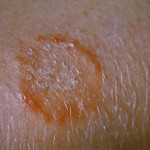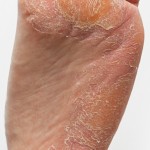| Skin fungus comes in many forms and can appear completely different looking on different pigmentations of skin. However, there are some general signs and symptoms to be aware of so that treatment can begin as soon as an infection is suspected. Skin fungus is the gateway to a nail fungus infection. A nail that is exposed by either being cut too short, mildly cracked or simply a hangnail around the nail bed is the way that fungus gets into the nail bed and then begins attacking the nail. So be wary of these types of skin fungus below so that you can avoid ever needing to cure toenail fungus!
Tinea Corporis (Ringworm)
 First of all, ringworm has nothing to do with worms so you can put your head to rest! The name comes from the shape of the fungal infection that develops under the skin. Ringworm is almost always in the form of a red, often dry-skinned circle underneath the outer layer of skin. Sometimes there are a few rings, sometimes is puffy or itchy or really dry. The reason for the many cases of ringworm is that it is an extremely easy fungal infection to spread but even the slightest contact. People, pets, public spaces and even contact with a surface where an infected person spent time recently can all spread ringworm. But on the positive side, there are quite a few reputable anti-fungal ringworm treatments that are very effective. First of all, ringworm has nothing to do with worms so you can put your head to rest! The name comes from the shape of the fungal infection that develops under the skin. Ringworm is almost always in the form of a red, often dry-skinned circle underneath the outer layer of skin. Sometimes there are a few rings, sometimes is puffy or itchy or really dry. The reason for the many cases of ringworm is that it is an extremely easy fungal infection to spread but even the slightest contact. People, pets, public spaces and even contact with a surface where an infected person spent time recently can all spread ringworm. But on the positive side, there are quite a few reputable anti-fungal ringworm treatments that are very effective.
Tinea Pedis (Athlete’s Foot)
 Athlete’s Foot is probably the most common form of skin infection because of the ease with which it spreads and the fact that most people badly neglect their feet. Drying or crackling skin around the ball of the foot, edges of the toes and back of the heel are all areas where the skin is often in bad shape and primed for an infection. Any exposed abrasion or crack in the skin is a way for the fungal agents to get inside the dermis. Redness will start most often on the toes and sole of the foot and can often become extremely itchy and eventually painful. Perhaps the worst part of athlete’s foot can be the exposure of an area around the nails. You do not want to let athlete’s foot spread into a situation where now you have to cure toenail fungus too! Wearing shower sandals in public locker rooms, showers, pools and all areas shared by the public where people go barefoot is an excellent way to keep your feet from contact with infected surfaces. Athlete’s Foot is probably the most common form of skin infection because of the ease with which it spreads and the fact that most people badly neglect their feet. Drying or crackling skin around the ball of the foot, edges of the toes and back of the heel are all areas where the skin is often in bad shape and primed for an infection. Any exposed abrasion or crack in the skin is a way for the fungal agents to get inside the dermis. Redness will start most often on the toes and sole of the foot and can often become extremely itchy and eventually painful. Perhaps the worst part of athlete’s foot can be the exposure of an area around the nails. You do not want to let athlete’s foot spread into a situation where now you have to cure toenail fungus too! Wearing shower sandals in public locker rooms, showers, pools and all areas shared by the public where people go barefoot is an excellent way to keep your feet from contact with infected surfaces.
Tinea Cruris (Jock Itch)
Jock itch is exactly that. Very common in athletes and also with people who have another existing fungal infection like athlete’s foot. Dry and often inflamed skin in your private parts is a very uncomfortable situation. Good hygiene goes a LONG way when keeping a body free from jock itch and athlete’s foot.
Tinea Capitis
Tinea capitis is an infection of the scalp that can come in quite a few different forms. In the United States, we are only exposed to the form of scalp fungus that shows itself as a single or group of black dots. In other parts of the world, a gray patch of dry looking and feeling skin can be exposed and this is usually found in cases where the fungus was spread from a domestic animal. Generally fungal scalp infections are found in young children. However, the problem with scalp infections is that they are often not detected until some level of hair loss appears.
Tinea Versicolor
Tinea versicolor is a fairly common skin infection caused by yeast. Teenagers are often at high risk for this infection which does will in an environment of sweaty or oily skin. Hormonal changes promote such a condition and the infection will show up as a discoloration of this skin. Uneven lightening patterns or patches on the skin are a dead giveaway and a good indication that it’s time to schedule an appointment with a medical professional.
|